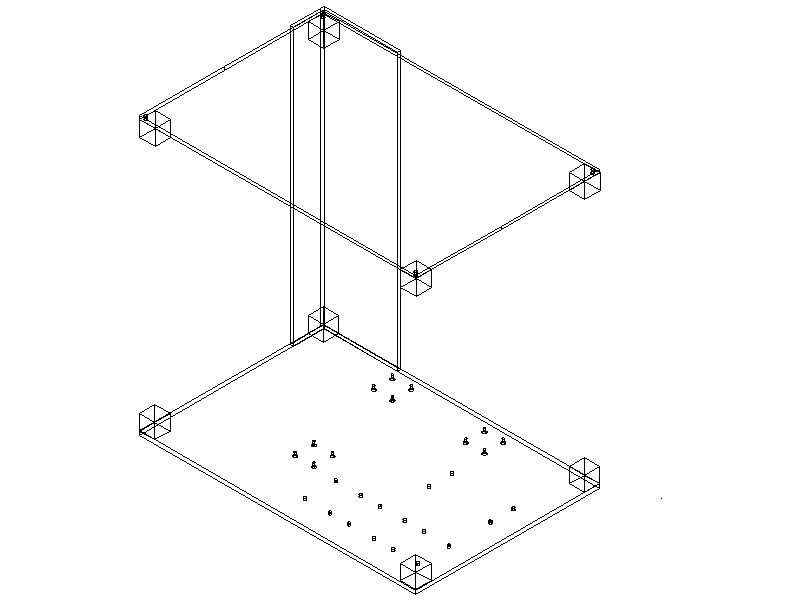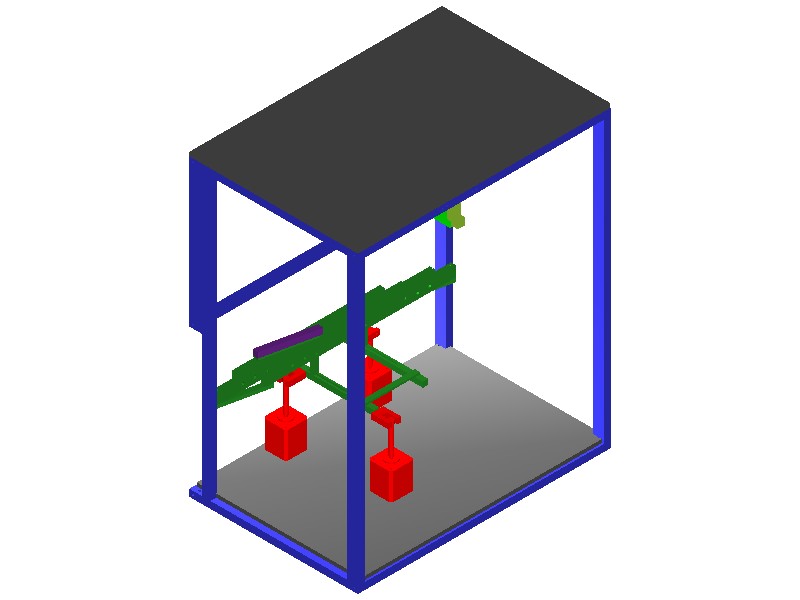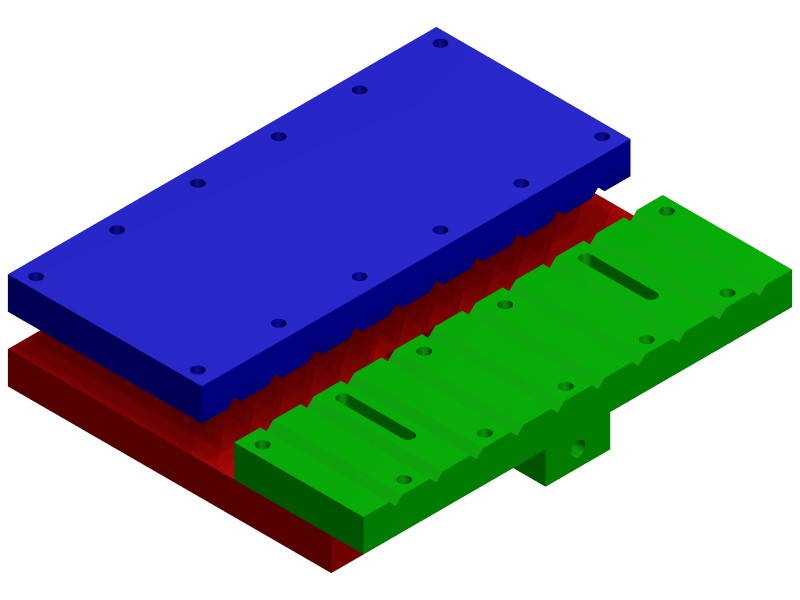Engineering Design and Fiber Arrays
About Me
I am soon to be a 7th semester Physics major, and I have been working with Dr. Jones and his lab group since more-or-less the beginning of summer 2008. My current work on the GlueX project relates to the mechanical engineering design and testing of the photon-tagging detector (microscope) which will be used in the Hall D experiment at the Jefferson National Accelerator Facility (J-Lab). I am also extremely involved in USA Cycling, where I work as a neutral support race mechanic at professional cycling races across the country (but mostly in the northeast).
The project that I am working on with Dr. Jones and his UConn lab group is the mechanical design of the tagger microscope enclosure, and the assembly of fiber optic arrays that it will contain. The tagger microscope is a critical part of the GlueX particle accelerator experiment being constructed and run at Thomas Jefferson National Accelerator Facility in Virginia. The GlueX project is overseen (and largely-funded) by the United States Department of Energy, but is executed by an international collaboration of physicists which includes students and faculty members from universities worldwide.
Project Abstract
The GlueX experiment is designed to probe the mechanisms of confinement of quarks and gluons inside hadrons. Quantum chromodynamics (QCD) is the accepted theory of the nuclear strong force, which explains the interactions of the quarks and gluons that compose hadrons. Quarks and gluons are subatomic particles which never live in isolation, but are always bound inside composite objects called hadrons. Gluons create the force that holds quarks together inside hadrons. Hadrons come in two types: mesons existing in their simple state of bound quark/antiquark pairs and baryons in their simplest form of three quarks. Mesons consist of only two fermions, and provide a unique opportunity for studying strong-interacting physics. Such an opportunity is analogous to the hydrogen atom in classical physics.
One fundamental hypothesis in the field of strong-interaction nuclear physics is confinement, which explains how quarks and gluons are the elementary particles of which the nucleus is made, even though isolated quarks and gluons have never been observed in an experiment. Confinement implies that an infinite amount of energy is required to isolate a quark outside of a hadron. One of the predictions of QCD is that the gluonic field inside hadrons has an independent degree of freedom from the quarks, and is capable of being independently excited. The energy and mode structure of the excitations give important information regarding the configuration of the gluonic fields, which ultimately lead to confinement.
The GlueX experiment searches for mesons with internal gluon excitations, called “exotic mesons.” The experiment will map these mesons by producing them with photon-proton collisions and subsequently measuring their quantum numbers by studying the angular distribution of their decay particles. The GlueX experiment will generate a photon beam beginning with a high-energy electron beam from the US Department of Energy’s Thomas Jefferson National Accelerator Facility, using the process of coherent bremsstrahlung. Coherent bremsstrahlung refers to electromagnetic radiation produced by the deceleration of electrons inside a diamond crystal. After the electrons emerge from the diamond, their energies are measured in a magnetic spectrometer called the “tagger”, which “tags” the energy of the photons produced in the diamond as the difference between the pre- and post-bremsstrahlung electron energies.
The tagger is a major component in the engineering design of GlueX. Members of the nuclear physics group at UConn have received funding from the US Department of Energy for the design and prototyping of electron detectors for the tagger. The design goals of this project include selection of optical fibers and waveguides for the electron detectors, the mechanical design and machining of a light-sealed case to contain the detectors, and the development of techniques for gluing them and mounting them on a precise remote-controlled alignment rail system. A prototype of the tagging fiber detector is currently being constructed, and will be tested at the Thomas Jefferson National Accelerator Facility in January 2010.
Summary of Fall 2008 Work
This semester, my work focused on the physics-engineering design of the tagger microscope box to be used for the GlueX particle accelerator project in Hall D at Jefferson National Lab in Virginia. The volume of work that I ultimately produced was not as much as I had hoped for, because I spent the first months of the semester learning the computer programs needed to facilitate my design work. Based on my current knowledge of these programs plus the final data and design files I was able to create, I would consider this semester a definite success.
The main computer program used for my project is TurboCad. TurboCad is a drafting program similar to both AutoCAD and Solid Works, but is better suited to my project because it allows more 2D and isometric views, as well as a full repertoire of snaps and rendering settings. The currently-marketed edition of TurboCad is Version 15.0, but for the GlueX design project I was working primarily with Version 12.0. It took some time into the semester until I could properly install it on my personal laptop, but after that time my work became infinitely more efficient. The TurboCad program was somewhat complicated to learn, but I did so successfully by using the help menus and tutorials, as well as by asking questions at lab meetings and experimenting on my own. The first challenge I gave myself was drafting a bicycle frame, and once I succeeded at this near the end of October, I began working exclusively on the Tagger design. The files I created for the Tagger design still need a lot of revision, which I hope to complete over the winter break and into next semester. Ideally, I would like to have the prototype Tagger box machined and assembled by sometime in February of 2009.
This semester, I learned that the process of designing the Tagger box is entirely experimental. Overall as a lab group, we have a general idea of how the box should be constructed, although this is subject to slight revisions on a weekly basis. Some of the main revisions integrated into the design this semester include the “skeleton” support structure versus a solid box to reduce weight, and the idea of using foil to form the sides of the box to access the fibers and motors inside. As each of these revisions was discussed and sketched out, it was my job to draft the new design in TurboCad – a process that became a great learning experience for me on many levels. In this same vein, I would characterize the entire Fall 2008 semester as a “great learning experience” for my design project. The presentable TurboCad files that I have created are indexed below. While they are not many in number, I believe that they accurately represent my growing confidence and comfort level with using the program. The majority of the Tagger’s skeleton is rendered, and I hope to work with our lab group and the Physics machine shop to expand on all of these designs in the coming weeks and months. For this semester, however, I feel that my greatest victory was learning the TurboCad program, which will be an invaluable tool for me to use in the future.
Summary of Spring 2009 Work
My work over the Spring 2009 semester can be categorized into four main topics:
1. Final CAD Renderings of the Microscope Enclosure
I define a "final" CAD file to be one that has both 3d and 2d views, and is fully-dimensioned to ANSI standards.
A final CAD file is ready to be printed and submitted to the machine shop for manufacturing and construction.
This semester I finalized the following files:
a) Base Plate - for the base of the microscope enclosure.
b) Top Plate - for the top of the microscope enclosure.
c) New Gluing Apparatus - a collaborative project that I took charge of.
This image shows the skeleton framework of the microscope, with the base plate and top plate attached.
2. Training for the Operation of CNC Machines
I continued working closely with Alan Chasse in the UConn Physics Machine Shop, and together we machined and constructed the new gluing apparatus. We began work on the base plate, but by the end of the semester all of the necessary parts for this had yet to be obtained, so our CNC work was delayed. Plans for machining the top plate are in the works for as soon as the base plate is done.
Working with CNC machines is something that I have wanted to learn, so I really enjoyed getting to use them directly this semester. I hope to continue doing work like this for my project in the future.
The primary machine that I used was a Bridgeport Milling Machine.
3. Training for and Investigation into Fiber Gluing Techniques
Carl Nettleton left our lab group in February 2009, and I took over his portion of work for the GlueX project.
I completed three successful gluing sessions of fibers in February and March, and worked through all other aspects of the process as "practice runs" under Carl's supervision. I also completed the UConn Environmental Health and Safety class to work with and maintain the chemicals used in our lab.
The majority of my work with the fiber arrays this semester related to the design and fabrication of a new gluing apparatus. It is my hope (as well as my experienced prediction) that this apparatus, coupled with the new optical epoxy mixture, will produce results that are far superior to the previous method used for gluing the optical wave guides to the scintillators.
This is a CAD rendering of the new gluing apparatus that was designed and built this semester to accelerate the gluing process.
4. "Frontiers of Undergraduate Research" Poster Presentation
The "Frontiers" poster presentation took place on April 17th and 18th, but I began preparations for it in late January. I submitted a formal abstract of my project, which was subsequently accepted to participate in the event. All poster design was done electronically using Microsoft Publisher 2007, and the posters were printed on the new HP poster printer in our lab.
My poster specifically addressed the main points of my work thus far in the lab: My abstract, the underlying physics of the GlueX project, my work with TurboCad, my work with the optical fibers, and my increasing use of the CNC machines. It was a total success. My poster can be found here.


